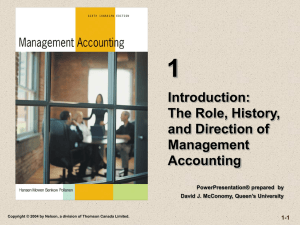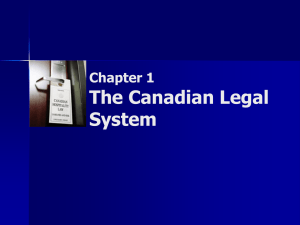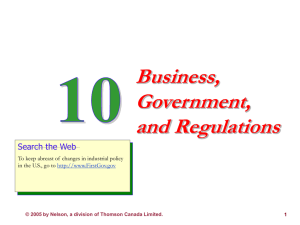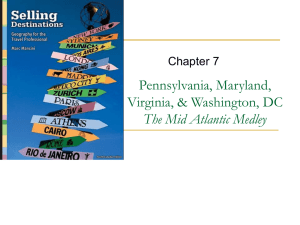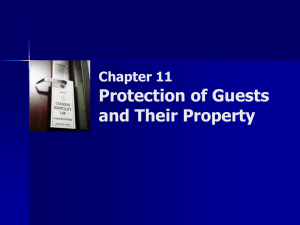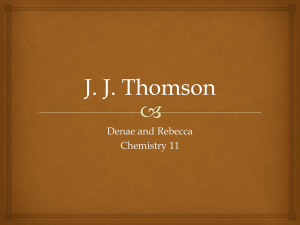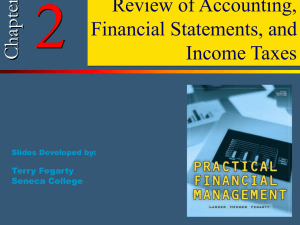Lecture 2 - Trent University
advertisement
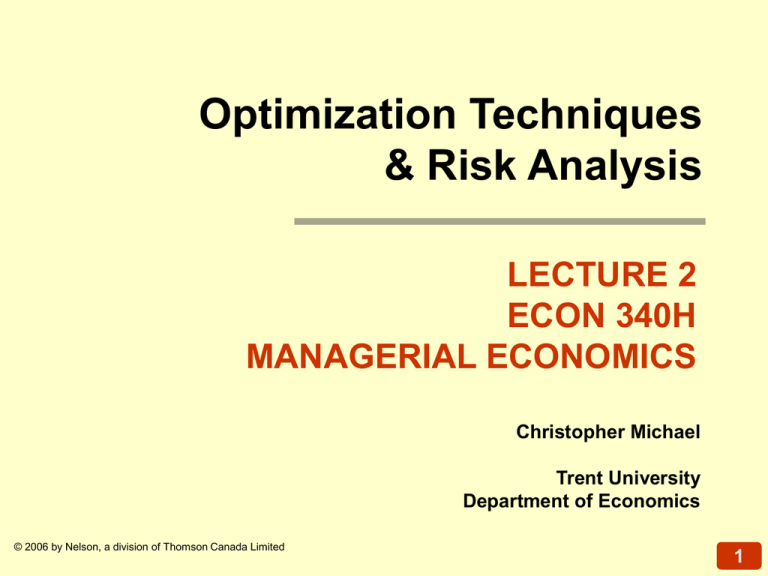
Optimization Techniques
& Risk Analysis
LECTURE 2
ECON 340H
MANAGERIAL ECONOMICS
Christopher Michael
Trent University
Department of Economics
© 2006 by Nelson, a division of Thomson Canada Limited
1
Topics
•
•
•
•
•
•
•
•
•
Maximizing the Value of the Firm
Total, Average, and Marginal Analysis
Finding the Optimum Point
Present Value, Discounting & Net Present Value
Risk and Expected Value
Probability Distributions
Standard Deviation & Coefficient of Variation
Use of a z-value
The Relationship Between Risk & Return
© 2006 by Nelson, a division of Thomson Canada Limited
2006 Thomson Nelson
2
Maximizing the Value of a Firm
• Optimal decision – choice alternative that
produces a result most consistent with
managerial objectives.
• Primary objective of management is assumed
to be the maximization of the value of the firm.
• Value Maximization is expressed:
n
Value Pr ofitt /(1 i) TRt TCt /(1 i)
t
t
t 1
© 2006 by Nelson, a division of Thomson Canada Limited
3
Cost Functions – AC, TC & MC
•
•
•
•
AC = TC/Q
MC = <>TC/<>Q
TC = AC*Q
As AC Falls, the MC
curve is below it,
when AC rises, MC
is above it and when
AC is lowest
AC=MC.
AC,MC
MC
AC
Q
© 2006 by Nelson, a division of Thomson Canada Limited
4
Total Revenue, Total Cost
& Profit Function
•
•
•
•
•
•
•
•
TR = P * Q
TR is a fcn of output
Or TR = F(Q)
TC = AC * Q
Profit = TR – TC
Profit = (P*Q) – (AC*Q)
Graph of output and profit
Possible Rule:
profit
GLOBAL
MAX
MAX
» Expand output until profits
turn down
» But problem of local maxima
vs. global maximum
A
© 2006 by Nelson, a division of Thomson Canada Limited
quantity B
5
Total Profits, Marginal and Average Profits
Profit per
time period ($)
E
D
Total profits ()
C
*
B
N
0
T
A
Q*
Output per time period (units)
© 2006 by Nelson, a division of Thomson Canada Limited
(a)
6
Con’d
Profit per unit
of output ($)
C
A
B
Average profit ()
()
Marginal profit ()
0
Q*Q 1
Q2 Q 3
Output per time period (units)
(b)
© 2006 by Nelson, a division of Thomson Canada Limited
7
Average Profit = Profit / Q
PROFITS
MAX
C
» Rise / Run
» Profit / Q = average profit
• Maximizing average
profit doesn’t
maximize total profit
B
profits
Q
• Slope of ray from the
origin
quantity
© 2006 by Nelson, a division of Thomson Canada Limited
8
Marginal Profits = /Q
Q1 is breakeven (zero profit)
maximum marginal profits
occur at the inflection point
(Q2)
Max average profit at Q3
Max total profit at Q4 where
marginal profit is zero
So the best place to produce is
where marginal profits = 0.
max
profits
Q3
Q4
Q2
Q1
Q
average
profits
marginal
profits
© 2006 by Nelson, a division of Thomson Canada Limited
Q
9
Total, Average and Marginal Relationships
• TR = 8Q – Q^2
Q and P
TR = 8Q-Q^2
TR=PQ
AR=TR/Q
MR=<>TR/<>Q
0 and 0
8(0)-(0)^2
0
----------
-------------
1 and 7
8(1)-(1)^2
7
7
7
2 and 6
8(2)-(2)^2
12
6
5
3 and 5
8(3)-(3)^2
15
5
3
4 and 4
8(4)-(4)^2
16
4
1
5 and 3
8(5)-(5)^2
15
3
-1
© 2006 by Nelson, a division of Thomson Canada Limited
10
Graphing Total, Average and
Marginal Relationships
$
TR=0
TR
AR
Q=1
© 2006 by Nelson, a division of Thomson Canada Limited
Q=5
MR
Q
11
TR, AR and MR - Relationships
• TR – slope is +ve & falls continuously
as long as TR is +ve.
• AR = TR/Q = Demand curve for any
product a firm faces.
• MR is +ve as long as TR increases.
• IF MR=0, TR is at maximum.
• IF MR<0, TR is decreasing.
© 2006 by Nelson, a division of Thomson Canada Limited
12
Marginal - Derivatives of Functions
• Concept of a derivative
Y = f (x) and marginal Y = <>Y/<>X
2
10
,
000
400
Q
2
Q
/ Q 400 4Q
dP/dQ = 0 = 400-4Q
4Q = 400
Q = 100
© 2006 by Nelson, a division of Thomson Canada Limited
13
Example – TR, TC and Profits
TR 41.5Q 1.1Q 2
TC 150 10Q 0.5Q 2 0.02Q 3
TR TC
41.5Q 1.1Q 2 150 10Q 0.5Q 2 0.02Q 3
150 31.5Q 0.6Q 2 0.02Q 3
Marginal Profits
d / dQ 31.5 1.2Q 0.06Q 2
d / dQ 0
Use Quadratic Equation to solve
2
X
b
b
4ac / 2a
b = -1.2 a = -0.06 and c = 31.5
© 2006 by Nelson, a division of Thomson Canada Limited
14
Q ( 1.2)
1.2 2 4( 0.0 6)(3 1.5) / 2( 0.0 6)
Q 1 . 2 1 . 4 4 7 . 5 6 / 0 .1 2
Q1 1.2 3 / 0.1 2
Q1 3 5
or
Q 2 1 .2 3 / 0 .1 2
Q2 1 5
Since negative outputs are not feasible Q1 does not
exist, therefore, Q2 = 15
Take the second derivative of the profit function and
set = 0
d 2
/ d Q2 1.2 0.1 2Q 0
0.1 2Q 1.2
Q 3
© 2006 by Nelson, a division of Thomson Canada Limited
2
Since d 2
Profits are
/
dQ
0
maximized
at Q2=15
15
d / dQ dTR / dQ dTC / dQ
d / dQ MR MC 0
MR MC
dTR / dQ 41.5 2.2Q
dTC / dQ 10 Q 0.06Q 2
MR MC
41.5 2.2Q 10 Q 0.06Q 2
31.5 1.2Q 0.06Q 2 0
Use quadratic equation and
Q1 = -35 and Q2 = 15
Since MR = MC at Q2 = 15
Profits maximized at Q2 = 15
© 2006 by Nelson, a division of Thomson Canada Limited
16
Graph
$ per time
period
TC
$500
MRat Q = 15
Upper breakeven point
400
300
Lower
breakeven
point
TR
MCat Q =15
200
100
0
MR= MCat Q =15
MC
MR
6
12 15 18
© 2006 by Nelson, a division of Thomson Canada Limited
24
30
17
Graph – Con’d
Output (Q) per time period
$ per time
period
200
Total profit
Marginal profit = 0 at Q = 15
100
0
6
12
15 18
30
Output (Q) per time period
© 2006 by Nelson, a division of Thomson Canada Limited
18
Present Value
» Present value recognizes that a dollar received
in the future is worth less than a dollar in hand
today.
» To compare monies in the future with today, the
future dollars must be discounted by a present
value interest factor, PVIF=1/(1+i), where i
is the interest compensation for postponing
receiving cash one period.
» For dollars received in n periods, the discount
factor is PVIFn =[1/(1+i)]n
© 2006 by Nelson, a division of Thomson Canada Limited
19
Net Present Value (NPV)
•
Most business decisions
are long term
»
•
capital budgeting, product
assortment, etc.
Objective: Maximize the
present value of profits
NPV = PV of future
returns - Initial Outlay
•
»
n
NCFt
NPV
t
t 0 (1 r )
Where NCFt is the net
cash flow in period t
© 2006 by Nelson, a division of Thomson Canada Limited
20
NPV Rule
• Do all projects that have positive net
present values. By doing this, the
manager maximizes shareholder
wealth.
• Good projects tend to have:
1. high expected future net cash flows
2. low initial outlays
3. low rates of discount
© 2006 by Nelson, a division of Thomson Canada Limited
21
Sources of Positive NPVs
• Brand identify
and loyalty
• Control over
distribution
• Patents or legal
barriers to entry
• Superior
materials
© 2006 by Nelson, a division of Thomson Canada Limited
• Difficulty for others to
acquire factors of
production
• Superior financial
resources
• Economies of large
scale or size
• Superior
management
22
Risk Analysis
•
•
•
In managerial decisions, the
manager does not know the
exact outcome of each possible
course of action.
In such cases, the firm faces
risk or uncertainty.
Probabilities and outcomes can
be known than risk exists, when
such probabilities and outcomes
are unknown or cannot be
estimated, we have uncertainty.
In evaluating and comparing
investment projects that are
subject to risk managers use
the concepts:
» Expected
value;
» Standard
deviation; and
» Coefficient of
variation.
© 2006 by Nelson, a division of Thomson Canada Limited
n
E () i Pi
i 1
n
( )
i 1
i
2
* Pi
23
Expected Value (Profit)
• Expected value (profit) of
a project subject to risk is
obtained by multiplying
each possible outcome or
profit from the project by
its probability of
occurrence and then
adding these products
such that:
• For investment projects
facing equal risk, the firm
will choose the project
with higher expected
value (profit)
© 2006 by Nelson, a division of Thomson Canada Limited
n
E () i Pi
i 1
i Pr ofits
i outcom es
Pi Pr obabilityofoutcom e
24
Standard Deviation
• The absolute risk of an
investment project can
be measured by the
standard deviation of
the possible profits from
the project.
• Greater is the possible
dispersion of the profits
from a project, the
greater is the project’s
standard deviation and
risk.
© 2006 by Nelson, a division of Thomson Canada Limited
n
( )
i 1
i
2
* Pi
25
Coefficient of Variation & Relative Risk
• To compare the relative
dispersion of the possible
profits, or risk, of two or more
projects, need to use the
coefficient of variation.
• It is the ratio of the standard
deviation to the expected
profit of each project.
• That is, a manager will
usually prefer a more risky
project only if it is expected
profit is sufficiently higher
than that of a less risky
project.
• Coefficient of Variation
(C.V.) = / r.
» C.V. is a measure of risk per
dollar of expected return.
• The discount rate for
present values depends on
the risk class of the
investment.
» Look at similar investments
• Corporate Bonds or
Government Bonds
• Domestic Common Shares
or Foreign Shares
/
© 2006 by Nelson, a division of Thomson Canada Limited
26
Examples – Expected Value
Strategy
States of Nature
Recession
Economic Boom
p = .30
Expand Plant
Don’t Expand
- 40
- 10
p = .70
100
50
• Payoff Matrix shows payoffs for each state of nature, for
each strategy.
© 2006 by Nelson, a division of Thomson Canada Limited
27
Example – Con’d
_
• Expected Value = r = ri pi .
_
• r = ri pi = (-40)(.30) + (100)(.70) = 58 if
Expand
_
• r = ri pi = (-10)(.30) + (50)(.70) = 32 if Don’t
Expand
• Assess the standard deviation
• Standard Deviation = =
© 2006 by Nelson, a division of Thomson Canada Limited
(r
_
i
- r ) 2. pi
28
Example - Standard Deviations
expand = SQRT{ (-40 - 58)2(.3) + (100-58)2(.7)}
= SQRT{(-98)2(.3)+(42)2 (.7)}
= SQRT{ 4116}
= 64.16
don’t = SQRT{(-10 - 32)2 (.3)+(50 - 32)2 (.7)}
= SQRT{(-42)2 (.3)+(18)2 (.7) }
= SQRT{ 756 }
= 27.50
Expanding has a greater standard deviation, but also has
the higher expected return.
© 2006 by Nelson, a division of Thomson Canada Limited
29
Example - Coefficient of Variation
Projects of Different Sizes:
If double the size, the C.V. is not changed!!!
Coefficient of Variation is good for comparing
projects of different sizes
Example of Two Project Choices
A:
Prob
.5
.5
X
10
20
}
}
}
B:
Prob
.5
.5
X
20
40
}
}
}
© 2006 by Nelson, a division of Thomson Canada Limited
R = 15
= SQRT{(10-15)2(.5)+(20-15)2(.5)]
= SQRT{25} = 5
C.V. = 5 / 15 = .333
R = 30
= SQRT{(20-30)2 ((.5)+(40-30)2(.5)]
= SQRT{100} = 10
C.V. = 10 / 30 = .333
30
z-Values
• z is the number of standard deviations away
from the mean
_
• z = (r - r )/
• 68% of the time within 1 standard deviation
• 95% of the time within 2 standard deviations
• 99% of the time within 3 standard deviations
Problem: income has a mean of $1,000
and a standard deviation of $500.
What’s the chance of losing money?
© 2006 by Nelson, a division of Thomson Canada Limited
31
Relationship Between
Risk and Return
• Required Return =
Risk-free return + Risk Premium
» Risk-free return is the return on an
investment with NO risk of default
» Risk premium is the potential reward an
investor expects from making a risky
investment
© 2006 by Nelson, a division of Thomson Canada Limited
32

